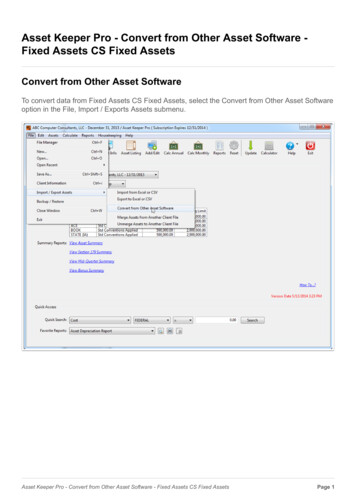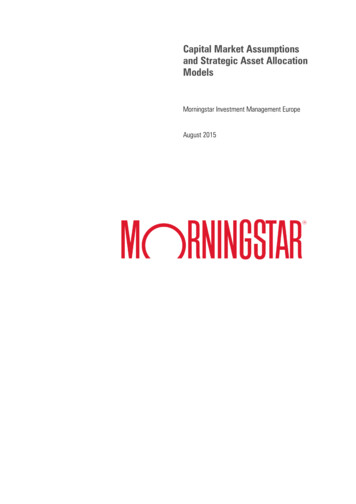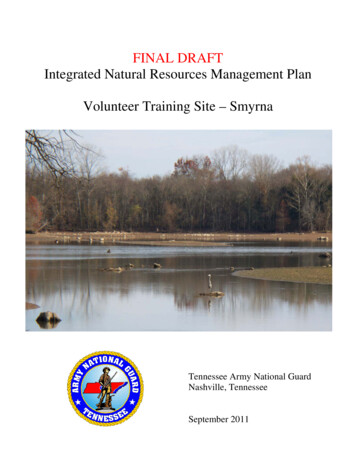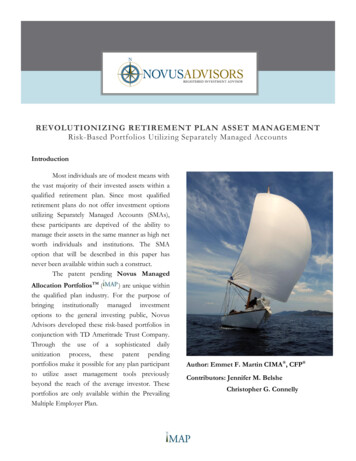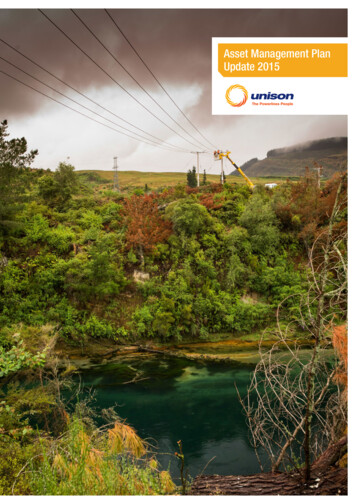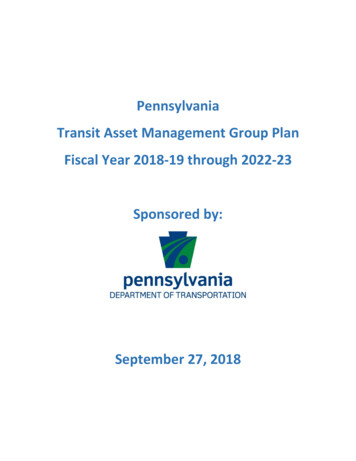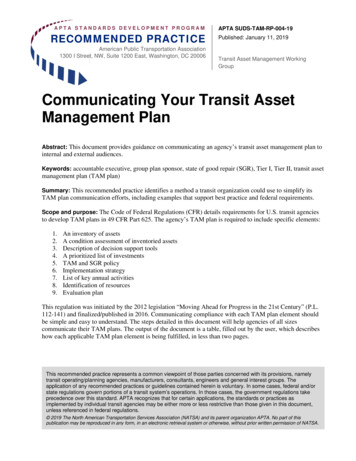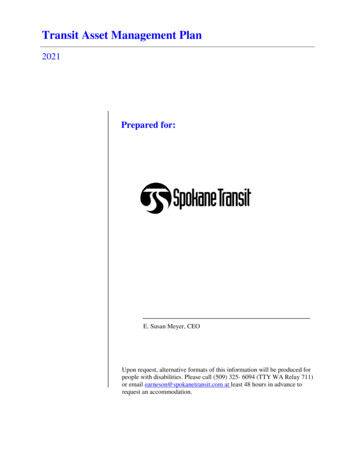
Transcription
StrategicAssetManagementPlan - DRAFTSTRATEGIC ASSETMANAGEMENT PLANS –GUIDELINES ANDTEMPLATE
Contents1.Introduction .21.1How to use this document .22.Strategic Asset Management Plans – General guidance and overview .32.1Long-term sector infrastructure strategies .33.Strategic Asset Management Plan – minimum requirements .34.SAMP template .44.1Executive summary .44.2Document approval .44.3Introduction .44.3.14.3.24.3.34.44.54.64.74.84.9Terms and definitions .4Organisational context and stakeholders .4Strategic alignment .5Asset Management Objectives .5Opportunities and constraints .6Current position ose and context . 4Scope . 4Timeframe . 4Current and historic performance levels (trends) . 6Gaps against current strategy targets and asset management objectives . 7Mitigation actions to address current strategy gaps . 7Future position .7Potential strategy scenarios .7Agreed strategy .8Strategy details .8Roles and responsibilities .8Performance management .9References to supporting documents .9Strategic Asset Management Plans – Guidelines and template
1.IntroductionThe Asset Management Policy for the NSW Public Sector – TPP19-07 (AM Policy) provides awhole-of-government framework to support agencies in realising value from their planned andexisting assets. Core Requirement 2 of the AM Policy calls for agencies to establish an assetmanagement framework that aligns with the AM Policy and the international standard for assetmanagement, ISO 55001 Asset management – Management systems – Requirements.Strategic asset management plans (SAMPs) are requisite artefacts expected to be produced byagencies as demonstration of the establishment an asset management framework. This documentoutlines the minimum requirements for SAMPs as prescribed by the AM Policy and providesdetailed guidance on how to prepare a SAMP based on industry best practice approaches1.1How to use this documentThis document is organised into four parts. This first part of the document provides an introductionand sets the context. The second part provides a general overview of what SAMPs are andgeneral guidance on what should be considered in their development. The third part lists theminimum requirements for a SAMP as stipulated in the AM Policy. Part 4 is the main component ofthe document and contains a template for a SAMP, with placeholders included to mark whereinformation required by the AM Policy might be placed. Additional guidance is provided in therelevant sections to assist agencies to understand the extent and detail of the information requiredto develop a fit-for-purpose SAMP.The template provided in this document is intended as guidance only. Provided that the AM Policyrequirements are met, amendments to the template or use of different document formats should beconsidered if it will result in a more fit-for-purpose document for the agency. The template providedin this document represents a foundational SAMP. It stipulates information agencies are expectedto provide at minimum to meet the requirements of the AM Policy.This document forms part of a suite of guidance documents developed to support agencies in theimplementation of the AM Policy requirements. This document should be read in conjunction withthe AM Policy itself and other guidelines produced to assist agencies with AM Policyimplementation.2Strategic Asset Management Plans – Guidelines and template
2.Strategic Asset Management Plans – General guidance and overviewISO 55000 defines a Strategic Asset Management Plan as “documented information that specifieshow organisational objectives are to be converted into asset management objectives, the approachfor developing asset management plans, and the role of the asset management system insupporting achievement of the asset management objectives”From a NSW public sector perspective, SAMPs describe the activities required to establish,maintain and improve the agency’s Asset Management Framework, including the outcomes(objectives) to be achieved from planned investment program.2.1Long-term sector infrastructure strategiesThere is significant crossover of content expected of a SAMP and that of long-term (20-year)sector-specific infrastructure strategies developed by some Governments departments. Agency’smay wish to combine the requirements of their infrastructure strategy with their SAMP as oneartefact to reduce duplication. However, if this is not possible and abridged SAMP can developedcovering aspects not included in the infrastructure strategy.3.Strategic Asset Management Plan – minimum requirementsA strategic asset management plan (SAMP) must be developed by the agency as part of its assetmanagement framework.The SAMP must be fit-for-purpose, meaning it must reflect the scope and complexity of theagency.SAMPs must contain the following as required by the AM Policy 1:1. overview of the organisational context2. overview of stakeholder needs3. Asset Management Objectives and their relationship with:a. the overall agency objectives as outlined in the organisational plan(s), including an agency’sBusiness and Outcomes Planb. the organisation’s asset portfolio4. the requirements for the asset management objectives and each Asset Management Plan(AMP)5. the scope and boundaries of the Asset Management Framework, the asset management andbusiness activities within the scope of the framework6. outline of the integration of the Asset Management Framework with other business frameworks,functions, plans and activities7. outline of organisational governance arrangements, including the agency’s Asset ManagementPolicy and the roles and responsibilities in place to support the Asset Management Framework8. outline of the roles, processes, systems and activities required to develop, implement, manageand improve the Asset Management Framework (including the SAMP itself) and the associatedAMPs.13Refer to ‘Part 3: Explanatory details’ of the Asset Management Policy, under the heading Strategic Asset Management Plan (SAMP)Strategic Asset Management Plans – Guidelines and template
4.4.1SAMP templateExecutive summaryThis section must include an overview of the detail in the SAMP and contain a summary of thescope, key actions and benefits to the organisation.4.2Document approvalThis section must include a high-level detail of the AMP’s approval and sign-off. It must include thatdate of approval, title of the approver and version control information.4.3Introduction4.3.1Purpose and contextThis section summarises the agency’s Asset Management Framework and broad approach toasset management. Linkages to the agency’s long-term financial strategy must also be outlined.It must detail the role of the SAMP within the agency’s broader Asset Management Framework. Adocument hierarchy so that readers understand where the SAMP sits in relation to the broaderAsset Management Framework is recommended.4.3.2ScopeThe scope must detail the assets and services that the SAMP covers, in line with the agency’sAsset Management Framework. If the agency intends on utilising their Department’s infrastructurestrategy to satisfy certain SAMP requirements, this section must outline those requirementscovered in the infrastructure strategy and the gaps covered by the SAMP4.3.3TimeframeState the agreed timeframe for the plan. Typically, this would be 20-years and must be consistentwith the agency’s organisational planning approach.This section must include a statement as to the expected accuracy of the plan at varying timehorizons, for example, the plan may provide a ten-year budgetary bid with indicative estimates.4.4Terms and definitionsInclude a list of terms and definitions used in the SAMP. As much as possible use terms fromrelevant standards and provide a reference to the source of the definition.Agencies should use the same terms and definitions consistently across all artefacts of their assetmanagement framework, including in their agency-level asset management policy and assetmanagement plans (AMPs).4.5Organisational context and stakeholdersThis section provides and overview of the agency. It must outline how the organisation’s structuresupports the agency’s Asset Management Framework.4Strategic Asset Management Plans – Guidelines and template
All key stakeholders (both internal to external to the agency) must be identified and their needsdetailed. It is important to describe any involvement a stakeholder will have in asset managementdecision making.4.6Strategic alignmentSAMPs must reflect Government’s strategic agendas and priorities. These are communicated invarious ways including through the NSW State Plan, Infrastructure NSW’s State InfrastructureStrategy, Premier’s Priorities, current and emerging policy and legislation, Budget statements andCabinet decisions.SAMPs must integrate and align with the major strategies of other agencies where relevant. Forexample, TfNSW’s Future Transport 2056, Greater Sydney Commission’s Sydney Region Plan,Department of Planning and Environment’s Regional Plans have significant implications forstrategic asset planning and must be considered in an agency’s development of their SAMP.There must also be a link between an agency’s Business and Outcomes Plan and their SAMP4.7Asset Management ObjectivesThe SAMP must outline the agency’s Asset Management Objectives. Asset ManagementObjectives must align with the Asset Management Principles of the AM Policy and be fit-forpurpose for the organisation.The Asset Management Principles of the AM Policy are as follows:1. assets exist to provide value by supporting government objectives2. agencies act as stewards of public assets on behalf of the government3. asset management decisions must have regard to the appropriate balance of cost, risk andperformance4. asset management must be integrated with other organisational functions, processes, activitiesand data5. asset management decisions must be made using a whole-of-life-cycle approachAgencies are required to apply these principles to their approach to asset management, whichmust be reflected in agencies’ asset management objectives. These objectives must demonstratea clear understanding of the links between an organisation’s functions, processes, plans and theresources required achieve outcomes.Part 3 of the AM Policy provides explanatory details of what needs to be considered in developingasset management objectives. This section is reproduced below for ease of reference:Asset management objectives are a key component of the agency’s AssetManagement Policy and the SAMP.Asset management objectives should be fit-for-purpose and would typically alignwith:– the requirements of relevant stakeholders– other financial, technical, legal, regulatory and organisational requirements(identified as part of the organisational context)– the desired performance of the Asset Management Framework, the assetmanagement function and the performance of asset(s)5Strategic Asset Management Plans – Guidelines and template
– the level of risk (financial and non-financial) associated with meeting theagency’s broader objectives– established processes for management reviews of the asset managementobjectives– the five principles of asset management, in particular the need to developthe d
Strategic Asset Management Plan – minimum requirements . Guidelines and template 2. Strategic Asset Management Plans – General guidance and overview ISO 55000 defines a Strategic Asset Management Plan as “documented information that specifies how organisational objectives are to be converted into asset management objectives, the approach for developing asset management plans,


